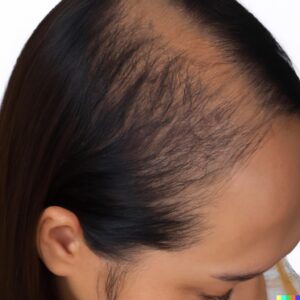Androgenetic Alopecia: The Most Common Cause of Hair Loss

Hair loss is a common concern that affects people of all ages and genders. Androgenetic Alopecia, often referred to as male or female pattern baldness, is the leading cause of hair loss. In this article, we will explore what Androgenetic Alopecia is, its causes, symptoms, and available treatment options.
What is Androgenetic Alopecia?
Androgenetic Alopecia is a genetic and hormonal form of hair loss that primarily affects men and women. It is often referred to as male or female pattern baldness due to the distinct pattern in which it progresses. While it is a hereditary condition, it can be influenced by various factors, including hormones, age, and genetics.
Causes of Androgenetic Alopecia
The primary cause of Androgenetic Alopecia is a combination of genetic and hormonal factors. It is often inherited from one’s parents, with specific genes contributing to an individual’s susceptibility to the condition. These genetic factors interact with hormones to influence the onset and progression of baldness.
In both men and women, the hormone dihydrotestosterone (DHT) plays a key role in Androgenetic Alopecia. DHT is a derivative of testosterone and can cause hair follicles to shrink, leading to the production of thinner and shorter hairs. Over time, affected hair follicles can become dormant and cease producing hair altogether.
Symptoms of Androgenetic Alopecia
The symptoms of Androgenetic Alopecia differ between men and women:
In Men:
- Hair loss typically begins with a receding hairline at the temples.
- Hair may also thin and recede at the crown, eventually forming a horseshoe-shaped pattern of hair around the sides and back of the head.
In Women:
- Women with Androgenetic Alopecia often experience diffuse hair thinning over the top of the scalp.
- The hairline generally remains intact, but the part may widen significantly.
Available Treatment Options
While Androgenetic Alopecia is a genetic and hormonal condition, there are treatments available to slow its progression and promote hair regrowth. Common treatment options include:
Minoxidil:
Minoxidil is a topical over-the-counter medication that can be applied to the scalp. It has been shown to help promote hair regrowth in both men and women with Androgenetic Alopecia.
Finasteride (For Men):
Finasteride is an oral prescription medication that works by inhibiting the conversion of testosterone to DHT. It can help slow hair loss and promote hair regrowth in men (always consult your medical doctor before using any of the therapies or suggestions).
Low-Level Laser Therapy:
Low-level laser therapy (LLLT) devices, such as laser combs or caps, can stimulate hair follicles and promote hair regrowth.
Hair Transplant:
Hair transplantation involves the surgical relocation of hair follicles from one part of the body to areas affected by Androgenetic Alopecia. It is often recommended for individuals with advanced hair loss.
Platelet-Rich Plasma (PRP) Therapy:
PRP therapy involves the injection of a concentration of the patient’s own platelets into the scalp. It can stimulate hair follicles and promote hair regrowth.
Coping with Androgenetic Alopecia
Coping with Androgenetic Alopecia can be emotionally challenging, as it often affects one’s self-esteem and self-image. Finding emotional support and connecting with others who share similar experiences can be valuable. Additionally, exploring available treatment options with a healthcare provider can provide a sense of control and confidence in managing this condition.
In conclusion, Androgenetic Alopecia is the most common cause of hair loss, affecting both men and women. While it is primarily a genetic and hormonal condition, various treatment options are available to slow its progression and promote hair regrowth. Seeking emotional support and consulting with healthcare professionals are essential steps in coping with Androgenetic Alopecia and regaining a sense of confidence and well-being.

